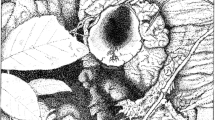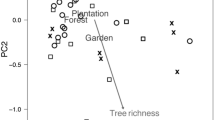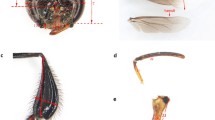Abstract
Wax constituents produced by worker bees and the chemistry of the nest batumen (mixture of wax, mud, and floral materials) in a Melipona scutellaris colony changed when it was invaded by Melipona rufiventris workers. Gas chromatography/mass spectrometry analyses showed that after invasion, the M. scutellaris workers of the invaded colony produced waxes with higher relative abundance of triacontanyl acetate and decreased the amounts of n-alkanes and n-9-alkenes. On the other hand, waxes from M. rufiventris workers displayed few changes. The change in the composition of the M. scutellaris waxes chemically differentiates that species from the M. rufiventris invader workers. Comparative analyses of batumens samples from pure and invaded colonies revealed greater amounts of terpenes and phenolic derivatives in the batumen from the invaded colony. This is the first report on the chemical characterization of batumens from stingless bees.



Similar content being viewed by others
References
Adams, R. P. 1995. Identification of Essential Oil by Gas Chromatography/Mass Spectroscopy. Allured Publishing, Illinois, p. 469.
Aguilar-Ortigoza, C. J.; Sosa, V., and Aguilar-Ortigoza, M. 2003. Toxic phenols in various Anacardiaceae species. Econ. Bot. 57:354–364.
Ashes, J. R., Haken, J. K., and Mills, S. C. 1980. Gas chromatography of esters-XII. Interrelationship of equivalent chain length (ECL) and retention index values of fatty esters. J. Chromatogr. 187:297–305.
Beekman, M. 2004. Is her majesty at home? Trends Ecol. Evol. 19:505–506.
Billen, J. 2006. Signal variety and communication in social insects. Proc. Neth. Entomol. Soc. Meet. 17:9–25.
Bonavita-Cougourdan, A., Clément, J. L., and Lange, C. 1987. Nestmate recognition: the role of cuticular hydrocarbons in the ant Camponotus vagus Scop. J. Entomol. Sci. 22:1–10.
Buser, H. R., Arn, H., Guerin, P., and Rauscher, S. 1983. Determination of double position in mono-unsaturated acetates by mass spectrometry of dimethyl disulfite adducts. Anal. Chem. 55:818–822.
Cruz-López, L., Patricio, E. F. L. R. A., and Morgan, E. D. 2001. Secretions of bees: the Dufour gland of Nannotrigona testaceicornis. J. Chem. Ecol. 27:69–79.
Cruz-López, L., Patricio, E. F. L. R. A., Maile, R., and Morgan, E. D. 2002. Secretions of stingless bees: cephalic secretions of two Frieseomelitta species. J. Insect Physiol. 48:453–458.
Flach, A. 2005. Ecologia Química de Maxillariinae, Spathodea campanulata e Meliponiinae. Tese de doutorado, Universidade Estadual de Campinas, Brazil, p. 178.
Gamboa, G. J., Reeve, H. K., and Holmes, W. G. 1991. Conceptual issues and methodology in kin-recognition research: a critical discussion. Ethology 88:109–127.
Howard, R. W. and Baker, J. E. 2003. Morphology and chemistry of Dufour glands in four ectoparasitoids: Cephalonomia tarsalis, C. waterstoni (Hymenoptera: Bethylidae), Anisopteromalus calandrae, and Pteromalus cerealellae (Hymenoptera: Pteromalidae). Comp. Biochem. Physiol. B, Biochem. Mol. Biol. 135:153–167.
Michener, C. D. 2000. The Bees of the World. The John Hopkins University Press, London, p. 913.
Morel, L. and Blum, M. S. 1988. Nestmate recognition in Camponotus floridanus worker ants: are sisters or nestmate recognized? Anim. Behav. 36:718–725.
Nascimento, V. A., Matusita, S. H., and Kerr, W. E. 2000. Evidence of hybridization between two species of Melipona bees. Genet. Mol. Biol. 23:79–81.
Nogueira-Neto, P. 1997. Vida e Criação de Abelhas Indígenas Sem Ferrão. Editora Nogueirapis, São Paulo, p. 446.
Nowbahari, E., Lenoir, A., Clément, J. L., Lange, C., Bagnères, A. G., and Jouilie, C. 1990. Individual, geographical and experimental variation of cuticular hydrocarbons of the ant Cataglyphis cursor (Hymenoptera: Formicidae): their use in nest and subspecies recognition. Biochem. Syst. Ecol. 18:63–73.
Obin, M. S. 1986. Nestmate recognition cues in laboratory and field colonies of Solenopsis invicta Buren (Hymenoptera: Formicidae): effect of environment and the role of cuticular hydrocarbons. J. Chem. Ecol. 12:1965–1975.
Patricio, E. F. L. R. A., Cruz-López, L., Maile, R., and Morgan, E. D. 2003. Secretions of stingless bees: the Dufour glands of some Frieseomelitta species (Apidae: Meliponinae). Apidologie 34:359–365.
Perrin, D. D., Armarego, W. L. F., and Perrin, D. R. 1980. Purification of Laboratory Chemicals, 2nd ed. Pergamon Press, Oxford, p. 557.
Pompeu, M. S. and Silveira, F. A. 2005. Reaction of Melipona rufiventris Lepeletier to citral and against an attack by the cleptobiotic bee Lestrimelitta limao (Smith) (Hymenoptera: Apidae: Meliponina). Braz. J. Biol. 65:189–191.
Roubik, D. W. 1989. Ecology and Natural History of Tropical Bees. Cambridge University Press, New York, p. 514.
Simmons, L. G., Alcock, J., and Reeder, A. 2003. The role of cuticular hydrocarbons in male attraction and repulsion by female Dawson’s burrowing bee, Amegilla dawsoni. Anim. Behav. 66:677–685.
Singer, T. L. 1998. Roles of hydrocarbons in the recognition systems of insects. Am. Zool. 38:394–405.
Van Den Dool, H. and Kratz, P. D. 1963. A generalization of the retention index system including linear temperature programmed gas–liquid partition chromatography. J. Chromatogr. 11:463–471.
Vincenti, M., Guglielmetti, G., Cassani, G., and Tonini, C. 1987. Determination of double position in diunsaturated compounds by mass spectrometry of dimethyl disulfite derivatives. Anal. Chem. 59:694–699.
Winston, M. L. and Michener, C. D. 1977. Dual origin of highly social behavior among bees. Proc. Natl. Acad. Sci. U. S. A. 74:1135–1137.
Acknowledgments
We thank Fundação de Amparo a Pesquisa do Estado de São Paulo for grants, which made the present contribution possible (Adriana Flach, Proc. no. 02/07029-0, and Adriana Pianaro, Proc. no. 03/09358-3). We also acknowledge Prof. Carol H. Collins (IQ/UNICAMP) for critically revising the manuscript.
Author information
Authors and Affiliations
Corresponding author
Rights and permissions
About this article
Cite this article
Pianaro, A., Flach, A., Patricio, E.F.L.R.A. et al. Chemical Changes Associated with the Invasion of a Melipona scutellaris Colony by Melipona rufiventris Workers. J Chem Ecol 33, 971–984 (2007). https://doi.org/10.1007/s10886-007-9274-5
Received:
Accepted:
Published:
Issue Date:
DOI: https://doi.org/10.1007/s10886-007-9274-5




